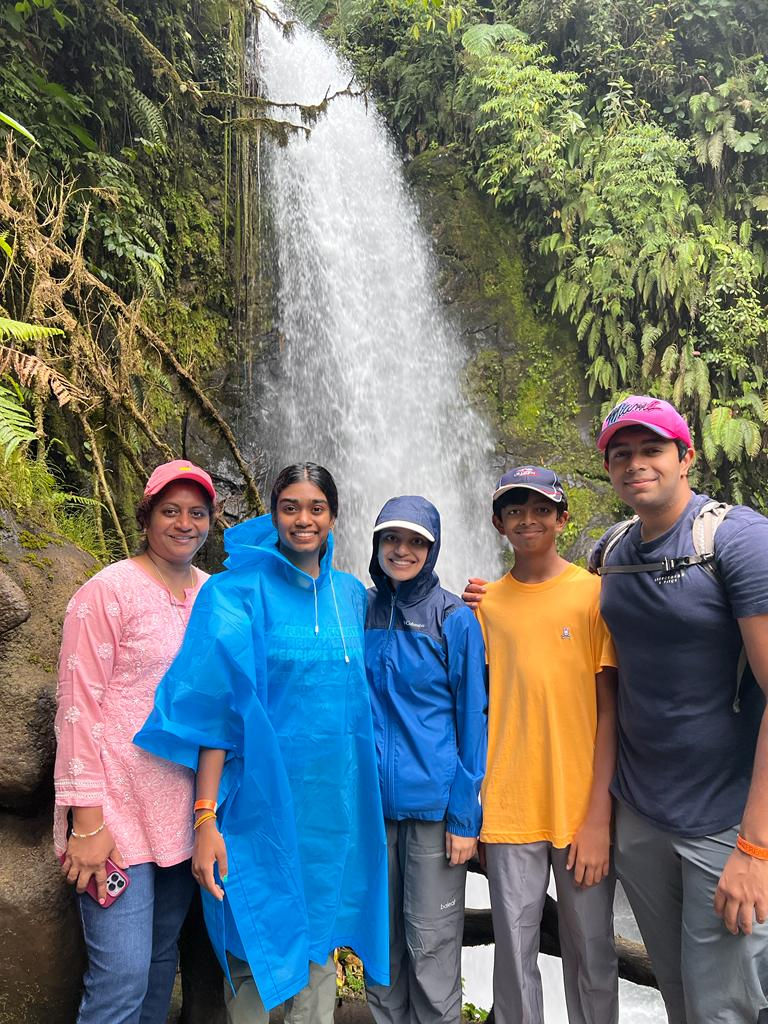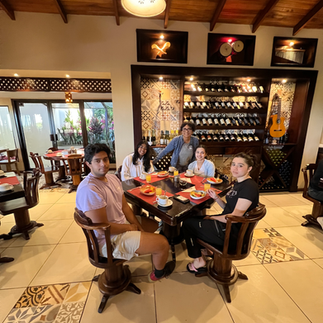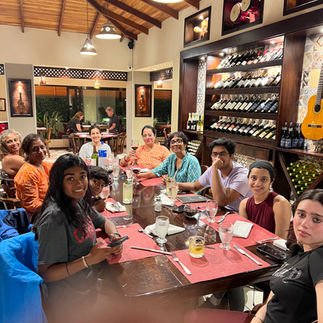From Rathi Raja and Madhu Allu
Gita Vicara Leadership Program
Our trip to Costa Rica was envisioned as a Prithvi~Mother Earth immersion for our young GVLP Board. We were hoping this would inspire a life-long commitment to leading an ecological life, mindful of our impact through thought, word and deed. Below we hear from Asvin Ranganathan, Saniya Gaitonde, Riya Gupta, Pranati Patnam and Naren Ranganathan on their reflections.

Asvin Ranganathan
Stony Brook University ‘26
My biggest takeaway from my trip to Costa Rica is the importance of a green world. In Costa Rica, the many vistas and views are only present because of the government’s efforts to preserve the natural land while they developed the country. While the US has some breathtaking locales as well, the amount of beauty that has been taken away from future generations is untraceable, as years of deforestation and other intrusive practices have removed these wonders.
An observation I made while in CR is that everyone I met was happy. Perhaps I had a skewed view, as workers in the tourism industry are generally proud of their country and happy to inform foreigners about their home country. However, even those that were not helping us seemed very positive and upbeat. This could be due to the greenery of CR, as trees and a biodiverse environment have been shown to positively impact a person’s mood.
Additionally, tourism is very widespread in Costa Rica due to their extensive natural locations. This has a profoundly positive impact on the nation’s economy as tourists not only pay tourist agencies and resorts for their trip, but also pay local restaurants, vendors, souvenir stores, coffee distributors and many other stores which ultimately benefit the government and the Costa Rican people.
Furthermore, Costa Rica’s government is focused on growing coffee in a sustainable way. Coffee beans, one of the nation’s biggest exports, earn the local coffee distributors and the government a lot of money. However, instead of tearing down the rainforests and defiling the land to grow coffee beans, a policy many other countries would enact, the government protected these natural areas and set aside
other lands to grow coffee beans in a non intrusive way. By doing this, distributors can make plenty of profit exporting the beans, and the beauty of Costa Rica is preserved.


Located on the slopes of Poás Volcano, Hacienda Alsacia is Starbucks’ first and only coffee farm as well as its global agronomy headquarters
Saniya Gaitonde
Barnard College ‘25
Our culture in the US today, defined by a rapid exchange of information and production of new things, promotes us to look outwards for fulfillment—to concern ourselves with what we don’t have rather than what is right in front of us. This can remove us from the present moment and make us lose sight of the simple abundance of our immediate surroundings. In Costa Rica, with our packed itinerary of outdoor activities, there was barely any time to be on my phone or get lost in faraway thoughts and I didn’t miss those things at all. It felt like all of my extra considerations were removed, and it was just me and nature, good food, and good company.
Even though at times it was difficult to be so far out of my comfort zone—enduring harsh rapids while white-water rafting, hauling luggage down muddy slopes in the rain, and hiking for hours in the hot sun—I felt very present at every moment and occupied only with my current sensations and perceptions. That, to me, is the meaning of “Pura Vida,” the greeting we received from almost every local we interacted with—to experience ‘pure life’ as it comes in the present moment.
During our trip, I was most inspired by the lifestyle and attitude of the Costa Rican people. Costa Rica is considered one of the happiest countries in the world, and this was immediately palpable as everyone we interacted with exuded a pure passion for their jobs and lives in Costa Rica. The Costa Rican lifestyle is deeply connected with the local environment. The local diet and most of our meals during our stay consisted of the locally grown rice, beans, meats, plantains, and coffee, and I was surprised by how delicious everything was given the simple ingredients and flavors.
This is one way in which Costa Ricans embrace taking pleasure in the simple things in life and in one’s immediate surroundings. Another example of this is their wonder and appreciation for the natural environment. I will never forget the enthusiasm with which our guide for our rainforest night walk described the beauty he saw in all of the different insect and snake species we saw. This stuck with me because I never thought of insects and snakes as beautiful before, but the vibrant colors combined with his contagious enthusiasm served as an important reminder that there are opportunities for wonder in the least expected places if you open your mind to it.
Overall, our trip to Costa Rica taught me the importance of living in the moment, taking pleasure in the simple things in life, and looking for the sources of wonder, joy, and fulfillment in my immediate surroundings. I hope to embody the spirit of “Pura Vida” in my everyday life and can’t wait for my next trip!

Our white-water rafting experience on the Rio Balsa

A colorful tiny insect spotted by our tour guide at the Manuel Antonio National Park
Riya Gupta
New York University ‘25
Costa Rica’s immersive natural experience is one that is truly special. Being able to view a volcano and monkeys from the comfort of my hotel was something that I will never forget! Costa Rican cuisine, especially the sea food, is very unique and of excellent quality. I’m going to miss the fresh salmon and mahi mahi.
Costa Rica’s animals make it one of the most beautiful places, and being able to walk through the picturesque, natural habitat was a truly humbling experience. I loved the monkeys and birds and walking through the cloud forest. Zip lining through this forest gave me a perspective that made me realize the infinitesimal existence of humans.
I love the bodies of water of Costa Rica and how prevalent they were all around me. White water rafting, hot springs, Hotel La Mariposa views, all were beautiful portrayals of vast bodies of water!
It's no surprise that Costa Rica is a country filled with beautiful natural ecosystems. Its coasts are bustling with marine life and its interior is blanketed with some of the most biodiverse forests in the world.
This was a bucket list trip that I thought I could check off and see every thing, but I was wrong! I definitely will have to come back. The hotels were extremely clean and luxurious. The tour guides were very humorous and added an exciting element to this trip. Also, the people in general are extremely friendly. It’s an enriching experience seeing the symbiosis between humans and animals. Being able to touch and taste and learn about medicinal plants inspired me to live a holistic life style.
My suitcase is full of amazing souvenirs like coffee and chocolates which are unlike anything I’ve ever had!
All in all, the abundance of wild life and scenery makes Costa Rica a must see place! Pura Vida 🦥🇨🇷🐒🦋🦜

Our view of the Arenal Volcano from Arenal Springs Resort

A rare sighting of the endangered Resplendent Quetzal at the Curi-Cancha Reserve, which protects cloud forest in Monteverde
Pranati Patnam
Cornell University ‘26
My time in Costa Rica has advanced my perception of the natural world and has left an eye opening legacy within my journey in art, poetry, and most importantly, the senses. Before my trip to this Central American paradise, I had always had a STEM focus on my views on the environment. From crunching numbers to predicting long term trends, the analytical and rational side of environmentalism has always been of value to me, because who can argue with cold, hard numbers?
This changed when I stepped into the heart of an active volcano for the first time in my life. A million questions went through my mind -- what type of rock was the crater made out of? Which gasses were being emitted from the center? How high was our current elevation? I had always wondered about these textbook-type questions in school or in my research. But seeing this majestic monstrosity in front of my very eyes had changed my perspective on it completely. Instead of inquiring more about the gaseous compounds being released, I chose to focus on feeling their warmth on my skin. The rock composition of the volcano -- which I found out later to be basaltic anthracite -- had no longer interested me; I just felt how grounded and connected I was to the solid rock beneath my feet. I didn't care how high above ground I was -- all I knew was that if I stretched my arms out high enough, I could touch the clouds.
This process of being present soon translated to the other areas of my trip. Seeing colors I’ve never seen before, hearing sounds of the lake and the wind and the leaves, tasting the ripest strawberries and richest coffees, I began to capture each wonder with a snipe of my camera. Later as I wrote and painted about them, I couldn’t help but feel so much more connected to the land around me. Seeing all the things I had learnt about in school finally come to life before my eyes was one of the most spiritual experiences I’ve felt to date. Whether it was seeing the elusive female quetzal to the brightest purple bananas, the most vivid of tropical sunsets to the thickest Ceiba tree trunks, my experience at Costa Rica was rich and meaningful and extremely unique to the country itself. After all, how close can you really get to a jaguar without getting lost in its eyes?

The Poás Volcano, an active 2,697-metre (8,848 ft) stratovolcano in central Costa Rica

A Ceiba tree in the Chachagua Rainforest, which the ancient Mayas believed to stand at the center of the earth, connecting the terrestrial world and the spirit-world
Naren Ranganathan
One big thing I noticed about Costa Rica is that the people adapted to their environment around them, compared to changing their environment to fit their needs. One benefit is that they have more space to work with since they don’t change it. This is better for the environment long-term because you keep the biodiversity, and you’re not spoiling the environment that was naturally there. This increases the amount of tourists that want to come to Costa Rica because they want to see the original environment. For example they built their roads to go around the mountain, rather than damaging the mountain by building tunnels or other roads that would further damage the environment on the mountain. The farmers of Costa Rica farm their crops such as coffee beans and plantains in safe, eco-friendly ways that don’t damage the environment. The people of Costa Rica use the natural waterfalls as tourist attractions, and have not interfered with it.

View from the airplane window while landing in Costa Rica

Some of our group members at the La Paz waterfall
Some more of our group photos!




















Comentarios